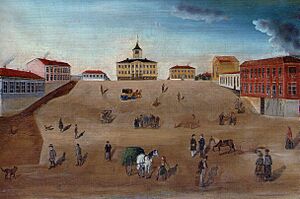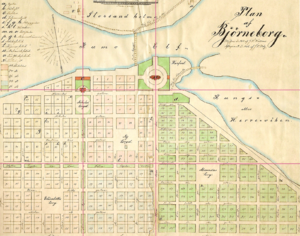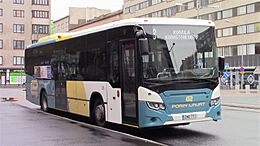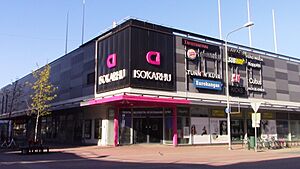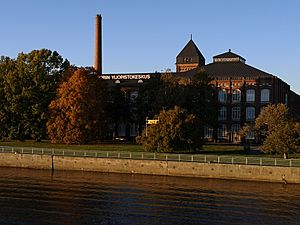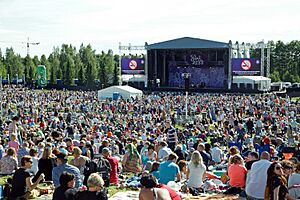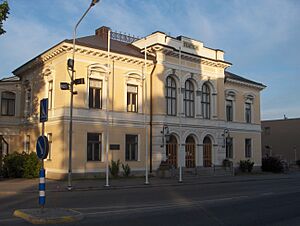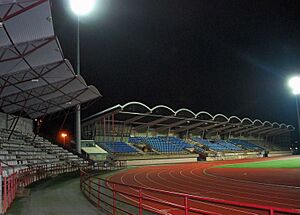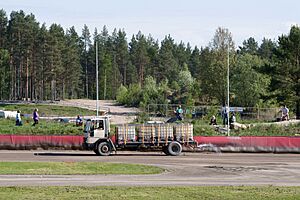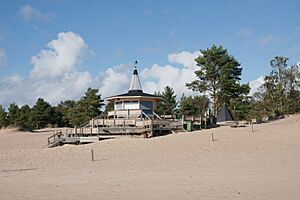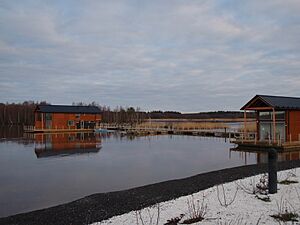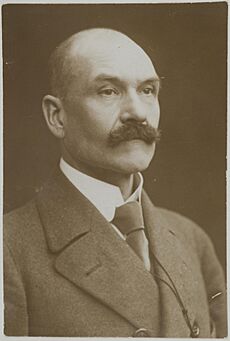Pori facts for kids
Quick facts for kids
Pori
Björneborg (Swedish)
|
|||
|---|---|---|---|
|
City
|
|||
| Porin kaupunki Björneborgs stad City of Pori |
|||

Montage of Pori
|
|||
|
|||
| Nickname(s):
Bear City
|
|||
| Motto(s):
"Deus protector noster." (English: "God is our protector.")
|
|||
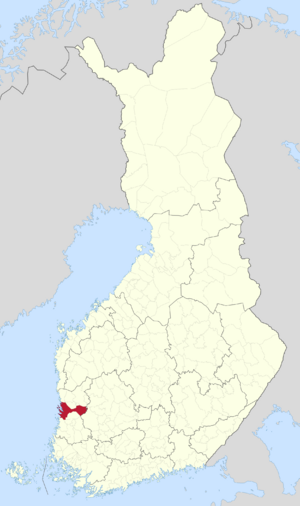
Location of Pori in Finland
|
|||
| Country | |||
| Region | |||
| Sub-region | Pori sub-region | ||
| Charter | March 8, 1558 | ||
| Area
(2018-01-01)
|
|||
| • City | 2,062.00 km2 (796.14 sq mi) | ||
| • Land | 1,156.16 km2 (446.40 sq mi) | ||
| • Water | 870.01 km2 (335.91 sq mi) | ||
| • Urban | 121.37 km2 (46.86 sq mi) | ||
| Area rank | 64th largest in Finland | ||
| Population
(2023-12-31)
|
|||
| • City | 83,106 | ||
| • Rank | 10th largest in Finland | ||
| • Density | 71.88/km2 (186.2/sq mi) | ||
| • Urban | 84,026 | ||
| • Urban density | 693.6/km2 (1,796/sq mi) | ||
| Population by native language | |||
| • Finnish | 94.3% (official) | ||
| • Swedish | 0.6% | ||
| • Others | 5.2% | ||
| Population by age | |||
| • 0 to 14 | 14% | ||
| • 15 to 64 | 59.7% | ||
| Time zone | UTC+02:00 (EET) | ||
| • Summer (DST) | UTC+03:00 (EEST) | ||
| Unemployment rate | 11.08% | ||
| Climate | Dfb | ||
Pori (pronounced 'POH-ree' in Finnish, or 'BJOR-neh-borg' in Swedish) is a lively city in Finland. It's the main city in the Satakunta region, located on the west coast by the Gulf of Bothnia. About 83,000 people live here, making it one of Finland's biggest cities.
Pori is about 10 kilometers from the sea, right where the Kokemäki River meets the Gulf of Bothnia. It's about 110 kilometers west of Tampere and 241 kilometers north-west of Helsinki, Finland's capital.
The city was founded in 1558 by Duke John of Finland, who later became King John III of Sweden. Pori is famous for its exciting Jazz Festival, the beautiful sandy beaches of Yyteri, and the Porin Ässät ice hockey team. It's also known for a local street food called porilainen.
Pori has faced many challenges, burning down nine times throughout its history. Only Oulu has burned more often. The city's coat of arms features a bear, and its motto, "Deus protector noster," means "God is our protector." This motto also appeared on Duke John's own coat of arms.
Contents
- What's in a Name? Pori's Meaning
- Pori's Past: A Look at History
- Exploring Pori's Landscape and Weather
- People of Pori: Demographics and Languages
- Getting Around: Transport in Pori
- Working in Pori: Economy and Jobs
- Learning in Pori: Education
- Pori's Creative Side: Culture and Arts
- Playing in Pori: Sports and Recreation
- Pori in the News: Media Outlets
- Must-See Places: Points of Interest in Pori
- Famous People from Pori
- Global Connections: Pori's Twin Cities
- Images for kids
- See also
What's in a Name? Pori's Meaning
The name "Pori" literally means 'Bear City'. It comes from the Swedish word "-borg," which means 'fortress' or 'castle'. So, the original Swedish name Björneborg means 'Bear Fortress' or 'Bear Castle'. The Latin name Arctopolis also means 'Bear City'.
Pori's Past: A Look at History
How Pori Began: Early Years
The city of Pori was founded on March 8, 1558, by Duke John of Finland. It took over from older towns like Teljä and Ulvila. Over time, it became harder for ships to sail up the Kokemäki River because the land was slowly rising after the last ice age. This meant the old towns were too far from the sea.
Duke John decided to build a new harbor and market town closer to the sea. He ordered people from Ulvila to move to the new city. Pori started with about 300 people who didn't want to move, but they soon found that the new location was great for trading. Shipbuilding was also important from the very beginning, with a shipyard opening in 1572.
Wars and Fires: Tough Times in Pori
Pori faced tough times during wars. In 1713, during the Greater Wrath, Russian troops occupied the city for four months. They damaged the city and stopped all foreign trade, causing Pori to go through a difficult period.
Later, during the Crimean War in 1855, Pori was attacked by French and British ships. The mayor made a deal with the enemy to save the city, giving them some ships and property.
Pori has also suffered from many fires because most of its buildings were made of wood. The city has burned down and been rebuilt nine times! The last major fire in 1852 destroyed over 75% of the city, leaving many people homeless. Only a few buildings, like the Town Hall, were saved. After this fire, a new city plan was designed by architect Georg Theodor von Chiewitz. He created wider streets and divided the city center into four parts to help prevent future fires.
Pori in the 20th Century: Civil War and World War II
During the Finnish Civil War in 1918, Pori was part of the side that supported workers' rights. While not directly on the battlefield, there were some violent events in the city.
In World War II, Pori was bombed four times by the Soviet Air Force between 1939 and 1940. Most bombs targeted the harbor. From 1942 to 1944, Pori Airport was a major air depot for the German air force. When the Germans left in 1944, they destroyed many of their facilities.
Exploring Pori's Landscape and Weather
River and Delta: Pori's Unique Geography
Pori is built on the estuary of the Kokemäenjoki river. Over hundreds of years, the land has slowly risen after the last ice age. This means that the city, which was once right on the coast, is now a bit further inland. The river's delta now starts in front of the city.
Kirjurinluoto, a popular recreation area, is actually an island connected to the mainland by bridges. The Pori National Urban Park helps protect the natural beauty and history of the area around the river mouth.
Pori's Climate: Weather Through the Seasons
Pori has a humid continental climate, which means it has warm summers and cold, snowy winters. The nearby Gulf of Bothnia helps to make the weather a bit milder than in northern Finland.
Summers are usually warm. The hottest temperature ever recorded in Pori was 33.3°C (91.9°F) in July 2010. Winters are long and cold, with the lowest temperature ever recorded being -36.8°C (-34.2°F) in February 1966.
The famous Yyteri beach is a favorite spot on warm summer days, attracting more visitors than any other beach in Finland.
| Climate data for Pori Airport, records 1960 - present | |||||||||||||
|---|---|---|---|---|---|---|---|---|---|---|---|---|---|
| Month | Jan | Feb | Mar | Apr | May | Jun | Jul | Aug | Sep | Oct | Nov | Dec | Year |
| Record high °C (°F) | 9.6 (49.3) |
9.5 (49.1) |
14.5 (58.1) |
24.5 (76.1) |
29.4 (84.9) |
32.9 (91.2) |
33.3 (91.9) |
33.2 (91.8) |
28.2 (82.8) |
20.1 (68.2) |
14.7 (58.5) |
11.3 (52.3) |
33.3 (91.9) |
| Mean daily maximum °C (°F) | −1.2 (29.8) |
−1.3 (29.7) |
2.4 (36.3) |
8.7 (47.7) |
15.0 (59.0) |
18.9 (66.0) |
21.8 (71.2) |
20.6 (69.1) |
15.3 (59.5) |
8.5 (47.3) |
3.3 (37.9) |
0.5 (32.9) |
9.4 (48.9) |
| Daily mean °C (°F) | −4.0 (24.8) |
−4.6 (23.7) |
−1.3 (29.7) |
4.0 (39.2) |
9.7 (49.5) |
14.1 (57.4) |
17.1 (62.8) |
15.8 (60.4) |
11.0 (51.8) |
5.4 (41.7) |
1.2 (34.2) |
−1.8 (28.8) |
5.6 (42.1) |
| Mean daily minimum °C (°F) | −7.0 (19.4) |
−7.6 (18.3) |
−4.9 (23.2) |
−0.4 (31.3) |
4.3 (39.7) |
9.0 (48.2) |
12.1 (53.8) |
11.0 (51.8) |
6.8 (44.2) |
2.3 (36.1) |
−1.3 (29.7) |
−4.8 (23.4) |
1.6 (34.9) |
| Record low °C (°F) | −35.7 (−32.3) |
−36.8 (−34.2) |
−27.1 (−16.8) |
−16.3 (2.7) |
−5.8 (21.6) |
−2.0 (28.4) |
1.7 (35.1) |
−1.1 (30.0) |
−7.3 (18.9) |
−16.7 (1.9) |
−22.5 (−8.5) |
−35.4 (−31.7) |
−36.8 (−34.2) |
| Average precipitation mm (inches) | 44 (1.7) |
28 (1.1) |
29 (1.1) |
30 (1.2) |
35 (1.4) |
54 (2.1) |
67 (2.6) |
71 (2.8) |
56 (2.2) |
66 (2.6) |
55 (2.2) |
51 (2.0) |
586 (23.1) |
| Average snowfall cm (inches) | 14 (5.5) |
14 (5.5) |
4 (1.6) |
0 (0) |
0 (0) |
0 (0) |
0 (0) |
0 (0) |
0 (0) |
0 (0) |
3 (1.2) |
8 (3.1) |
43 (16.9) |
| Average rainy days | 18 | 13 | 12 | 9 | 9 | 11 | 12 | 14 | 13 | 15 | 16 | 17 | 159 |
| Source: Climatological statistics of Finland 1981–2010
Source 2: Foreca |
|||||||||||||
People of Pori: Demographics and Languages
Population Growth in Pori
| Historical population | ||
|---|---|---|
| Year | Pop. | ±% |
| 1900 | 13,482 | — |
| 1910 | 13,981 | +3.7% |
| 1920 | 13,928 | −0.4% |
| 1930 | 15,966 | +14.6% |
| 1940 | 18,230 | +14.2% |
| 1950 | 43,306 | +137.6% |
| 1960 | 52,542 | +21.3% |
| 1970 | 72,938 | +38.8% |
| 1980 | 78,405 | +7.5% |
| 1985 | 78,376 | −0.0% |
| Source: City of Pori, Yearbook 2018 | ||
Pori has about 83,000 residents, making it one of the largest cities in Finland. The population grew a lot in 1950 when nearby areas joined the city. It reached its highest point in the mid-1970s with over 80,000 people. Recently, the population has stayed steady.
| Year | Population |
|---|---|
| 1990 |
85,348
|
| 1995 |
85,620
|
| 2000 |
84,573
|
| 2005 |
84,455
|
| 2010 |
85,026
|
| 2015 |
85,363
|
| 2020 |
83,684
|
Languages Spoken in Pori
Population by mother tongue (2023) Finnish (94.3%) Russian (0.9%) Swedish (0.6%) Arabic (0.4%) English (0.4%) Ukrainian (0.4%) Estonian (0.3%) Other (2.7%)
Pori is mainly a Finnish-speaking city. While only a small number of people speak Swedish as their first language, many people learn Swedish and English in school.
Over 40 different languages are spoken in Pori. The most common foreign languages include Russian, Arabic, Ukrainian, and English.
Immigration and Diversity in Pori
| Population by country of birth (2022) | ||
| Nationality | Population | % |
|---|---|---|
| 79,177 | 95.2 | |
| 452 | 0.5 | |
| 446 | 0.5 | |
| 250 | 0.3 | |
| 232 | 0.3 | |
| 185 | 0.2 | |
| 156 | 0.2 | |
| 154 | 0.2 | |
| 147 | 0.2 | |
| 123 | 0.1 | |
| 108 | 0.1 | |
| Other | 1,775 | 2.1 |
In 2023, about 5.2% of Pori's population had a background from another country. Most foreign-born residents came from the former Soviet Union, Russia, Estonia, and Iraq. Pori also has a Swedish School and a Swedish Culture Club for the Swedish-speaking minority in the Satakunta region.
Getting Around: Transport in Pori
Pori has a railway station and a bus station in the city center. Train services are mostly to Tampere. However, bus services are very busy, connecting Pori to major Finnish cities like Helsinki, Turku, and Tampere, as well as smaller towns. The city's own bus company, Porin Linjat, manages public transport.
Major highways connect Pori to other cities: Highway 2 to Helsinki, Highway 8 to Turku (south) and Vaasa (north), Highway 11 to Tampere, and Highway 23 to Jyväskylä.
Pori Airport has daily flights to Helsinki Airport and Stockholm Airport. There are also seasonal flights to ski resorts in Lapland and charter flights to sunny Mediterranean countries.
The Port of Pori handles mostly bulk cargo. In 2013, Pori was the destination for the MS Nordic Orion, the first commercial cargo ship to ever travel through the Northwest Passage from Canada.
Working in Pori: Economy and Jobs
In 2014, Pori had over 35,000 jobs. The city of Pori itself is the largest employer, with more than 5,000 employees. Other big employers include Technip and Satakunta University of Applied Sciences. In May 2018, the unemployment rate was 10.7%.
Learning in Pori: Education
Pori has 28 schools for younger students and 7 high schools (gymnasiums). Some high schools offer classes in English, French, and German. There's also a Swedish-speaking school, a Rudolf Steiner School, and a Christian school. The first school in Pori was founded in 1641.
For higher education, Pori has the Satakunta University of Applied Sciences and the University Consortium of Pori (UCPori). There are also vocational schools, including the music school Palmgren Conservatory and the Finnish Aviation Academy.
Pori's Creative Side: Culture and Arts
In 1987, the Art Association NYTE, a group for artists, was founded in Pori.
Pori Jazz Festival: A World-Famous Event
Pori is most famous for its international jazz music festival, which started in 1966. Today, Pori Jazz is one of Europe's biggest jazz festivals and a major cultural event in Finland. The festival lasts nine days in July. Many famous musicians have performed there, including B. B. King, Ray Charles, Miles Davis, Bob Dylan, and Elton John.
The main concert area is Kirjurinluoto Arena, an outdoor park that can hold over 30,000 people. It has also hosted other big events like the Sonisphere Festival. The SuomiAreena, a public debate forum, takes place at the same time as Pori Jazz.
Theatre and Music: Pori's Performing Arts
Pori is considered the birthplace of Finnish-language theatre. The Finnish National Theatre gave its first performance in Pori in 1872. The Pori Theatre is a local theatre that opened in 1931. Its building was completed in 1884.
Pori also has the Pori Sinfonietta, a symphony orchestra founded in 1938. They perform in the Promenadikeskus music hall. A famous classical composer from Pori is Selim Palmgren, sometimes called "The Finnish Chopin." The Pori Opera started in 1976 and performs a yearly show.
Museums: Discovering Pori's History and Art
The Satakunta Museum is a historical museum that opened in 1888. It's one of Finland's oldest historical museums and shows the history of the Satakunta region and Pori.
The Pori Art Museum focuses on contemporary and modern art. It opened in 1979 and is based on the art collections of Maire Gullichsen, a local art collector. The museum is in a building that was once a weigh house, built in 1860.
Other museums in Pori include the Rosenlew Museum, which tells the story of the Rosenlew Company's industrial past, and the natural history museum Luontotalo Arkki.
Playing in Pori: Sports and Recreation
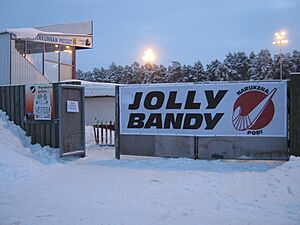
The most popular team sports in Pori are ice hockey and football. Pori is well-known for its ice hockey team, Ässät, which has won the Finnish championship three times. Their victory parade in 2013 brought about 20,000 people to the market square! The local football team, FC Jazz, won the Finnish premier league in 1993 and 1996.
Other popular team sports include bandy and pesäpallo, which is like the Finnish version of baseball. The women's pesäpallo team, Pesäkarhut, and the bandy team, Narukerä, both play in the top divisions. Pori also has teams for futsal, American football, rugby union, and floorball. The oldest sports club in Finland, Segelföreningen i Björneborg, was founded in Pori in 1856.
Sports Facilities in Pori
The Pori Stadium, which can hold 12,300 people, is mainly used for football and is one of Finland's largest multi-purpose stadiums. It's the home ground for FC Jazz. The stadium has also hosted international football games and the Finnish Championships in Athletics.
The stadium is part of the Isomäki sports center. This area also has the Isomäki Areena ice hockey arena for 6,150 spectators, an indoor football arena, a rink for bandy and skating, tennis courts, and an outdoor swimming stadium. The Pori Racetrack is a major venue for horse racing.
The motorcycle speedway track, Yyterin speedwaystadion, is about 16 kilometers north of the city. It has hosted the final of the Finnish Individual Speedway Championship many times. Yyteri Golf is also in this area.
Pori's city-owned indoor swimming pool opened in 2011. It's a modern facility with seven pools, three saunas, and a gym.
Famous Athletes from Pori
Pori has produced many talented athletes. Olympic gold medalists from Pori include wrestler Kelpo Gröndahl (1952) and weightlifter Kaarlo Kangasniemi (1968). Leo-Pekka Tähti, a five-time Paralympic gold medalist in sprint events, is also from Pori.
Other Olympic medalists from Pori include swimmer Arvo Aaltonen, weightlifter Jouni Grönman, boxers Joni Nyman and Jyri Kjäll, pole vaulter Eeles Landström, archer Kyösti Laasonen, and ice hockey players Sakari Salminen and Sari Marjamäki.
Currently active famous athletes from Pori include swimmer Matti Mattsson, hurdler Nooralotta Neziri, and NHL ice hockey players Joonas Korpisalo, Jesperi Kotkaniemi, Joel Armia, and Erik Haula. Mikko Salo won the 2009 CrossFit Games and was named the "World's Fittest Man."
Pori in the News: Media Outlets
The most popular daily newspaper in the Pori area is the independent Satakunnan Kansa.
Radio Pori was one of Finland's first commercial radio stations, started in 1985. Yle Satakunta is the local public radio station. Yle TV2 also shows daily local news from the Pori region.
Must-See Places: Points of Interest in Pori
Yyteri Beach is a stunning six-kilometer-long sandy beach located 17 kilometers from the city center. It's one of the largest beaches in the Baltic Sea and a popular spot for windsurfers. Yyteri has a hotel/spa, a camping park, and a golf course.
The island of Reposaari is about 10 kilometers further from Yyteri and is connected to the mainland by highway. It's a unique village with many wooden buildings and a population of about 1,000 people. Reposaari has a church, a marina, a hostel, and several restaurants.
The Juselius Mausoleum at the Käppärä Cemetery was built in 1901 for the 11-year-old daughter of businessman Fritz Arthur Jusélius. It's the only mausoleum in Finland and is decorated with beautiful paintings by Akseli Gallen-Kallela, one of Finland's most famous painters.
Kirjurinluoto is an island and park in the delta of the Kokemäenjoki river, right by the city center. On the south side of the river, you can see the beautiful Empire style buildings of the "old town," which were built after the 1852 city fire. The Pori Old Town Hall, built in 1841, is one of the few buildings that survived the fire.
The Central Pori Church and the Greek Orthodox Church of Pori are important churches in the city. About 10 kilometers outside Pori, in the municipality of Ulvila, you can find the medieval St. Olaf's Church and the 18th-century ironworks of Leineperi.
Villa Mairea, designed by Finland's most famous architect Alvar Aalto, is considered one of his most important works. It's well-known worldwide among people interested in modern architecture. Villa Mairea is located in Noormarkku, an area that became part of Pori in 2010.
The northernmost district of Pori, Ahlainen, is a charming seaside village with wooden houses. Its wooden church, built in 1796, is the oldest church building still standing in Pori. Eteläranta ("South Shore"), along the Kokemäki River, is a valuable area of Pori with stone house blocks built after the Great Fire of Pori in 1852.
Famous People from Pori
- Arvo Aaltonen (1892–1949), Olympic bronze medalist in swimming
- Lorenz Nikolai Achté (1835–1900), opera singer and composer
- Joel Armia (born 1993), professional ice hockey player
- Tuure Boelius (born 2001), YouTuber, singer, and actor
- Danny (born 1942), singer and guitarist
- Samuli Edelmann (born 1968), actor and singer
- Akseli Gallen-Kallela (1865–1931), famous painter
- Eino Grön (born 1939), singer
- Jenni Haukio (born 1977), poet and First Lady of Finland
- Lotta Henttala (born 1989), racing cyclist
- Kari Hotakainen (born 1957), author
- Laura Huhtasaari (born 1979), politician
- Fritz Arthur Jusélius (1855–1930), industrialist
- Krista Kiuru (born 1974), politician
- Timo Koivusalo (born 1963), film director and actor
- Aleksandr Kokko (born 1987), football player
- Anna Kontula (born 1977), sociologist and politician
- Jesperi Kotkaniemi (born 2000), professional hockey player
- Olli Lindholm (1964–2019), singer and guitarist
- Kari Mäkinen (born 1955), archbishop
- Visa Mäkinen (born 1945), film director and producer
- Nooralotta Neziri (born 1992), 100-meter hurdler
- Joonas Nordman (born 1986), actor and comedian
- Niko Palonen (born 1989), professional ice hockey player
- Risto E. J. Penttilä (born 1959), businessman and politician
- Emil von Qvanten (1827–1903), poet and politician
- Miro Rahkola (born 1988), ice hockey player
- Marjatta Raita (1944–2007), actress
- Tero Saarinen (born 1964), dance artist and choreographer
- Sakari Salminen (born 1988), professional ice hockey player
- Johan Eberhard von Schantz (1802–1880), admiral and explorer
- Kai Setälä (1913–2005), physician and professor
- Jorma Uotinen (born 1950), dancer, singer, and choreographer
Global Connections: Pori's Twin Cities
Pori has special connections with other cities around the world, called "twin towns" or "sister cities." These connections help promote friendship and understanding between different cultures. Pori is twinned with:
 Bremerhaven, Germany, since 1967
Bremerhaven, Germany, since 1967 Eger, Hungary, since 1973
Eger, Hungary, since 1973 Kołobrzeg, Poland, since 1975
Kołobrzeg, Poland, since 1975 Mâcon, France, since 1990
Mâcon, France, since 1990 Porsgrunn, Norway, since 1956
Porsgrunn, Norway, since 1956 Riga, Latvia, since 1965
Riga, Latvia, since 1965 Stralsund, Germany, since 1968
Stralsund, Germany, since 1968 Sundsvall, Sweden, since 1940
Sundsvall, Sweden, since 1940 Sønderborg, Denmark, since 1952
Sønderborg, Denmark, since 1952
Images for kids
-
Illustration in Finland framstäldt i teckningar edited by Zacharias Topelius and published 1845-1852.
See also
 In Spanish: Pori para niños
In Spanish: Pori para niños




